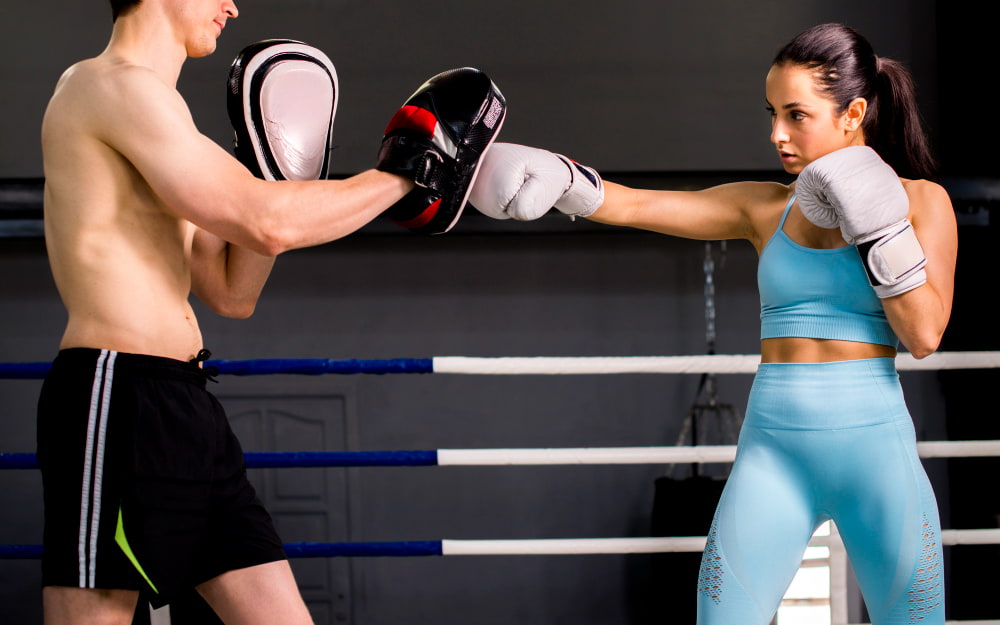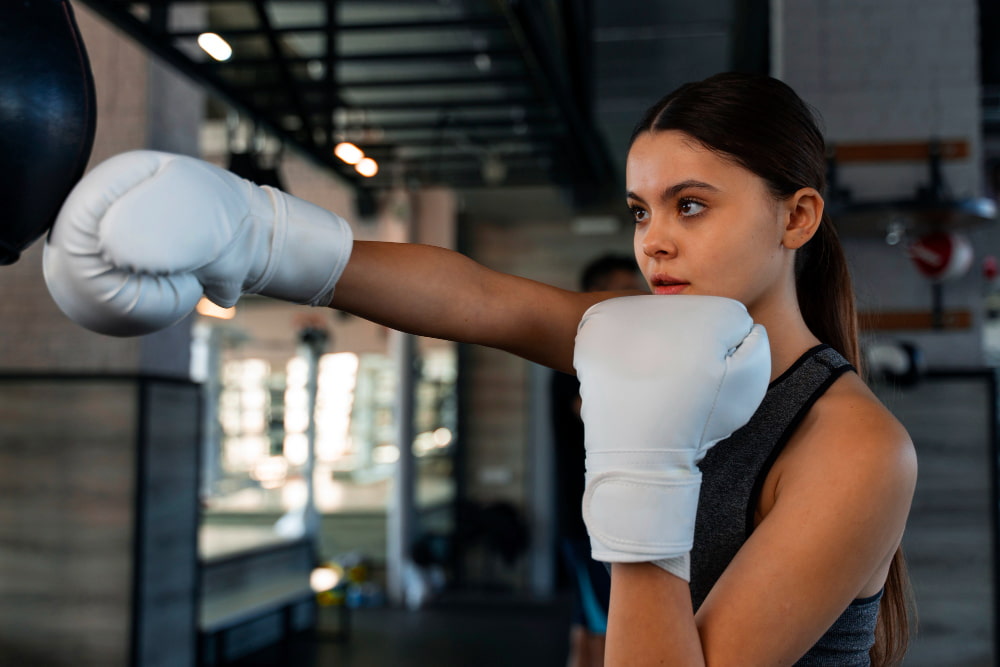
Welcome » Welcome » Boxing exercises » Plyometric boxing exercise: boost your performance
Are you looking to improve your boxing performance? Plyometrics are key. This article explains how to incorporate these explosive exercises to boost your power and speed.
Plyometrics strengthens muscles and tendons, improves coordination and prevents injuries. Programs adapted to each level guide you step by step. Discover the essential exercises to become faster and more powerful in the ring.
Plyometrics, often referred to as jump training, is a method of exercise designed to improve muscular power and reactivity in combat sports. This type of training focuses on fast, explosive movements, such as jumps and rebounds, to intensely load muscle fibres. By performing plyometric exercises, you work mainly on the stretching-shortening cycle of the muscles, which helps to develop explosive strength and speed.
The origins of plyometrics date back to the 1960s, when Soviet researchers were looking to improve athletic performance. They discovered that specific jumping exercises could greatly increase muscle power and reaction speed. This method then spread worldwide, becoming a mainstay in the training of top-level athletes, particularly in disciplines requiring power and speed, such as boxing.
Today, plyometrics is integrated into various sports training programmes because of its many benefits. It is particularly prized for its effectiveness in strengthening muscles, improving coordination and preventing injury. In boxing, these benefits are crucial, as they enable boxers to develop explosive punching power and fast, precise movements in the ring.
There explosive power is essential in boxing. Each punch must be fast and powerful to be effective. Plyometrics help to develop your explosiveness by strengthening the fast muscle fibres. Exercises such as high jumps and clap push-ups increase the muscles' ability to generate force quickly. For a boxer, this translates into more powerful punches, capable of making the difference in a fight.
Plyometrics is not just about developing power. It also plays a crucial role in strengthening muscles and tendons. Plyometric exercises, by intensely soliciting the muscles, increase their resistance and elasticity. This strengthening is particularly beneficial for boxers, who not only have to hit hard but also absorb impacts. Stronger muscles and tendons reduce the risk of injury and increase athletic longevity.
In boxing, speed is often decisive. The ability to react quickly to an opponent's attack or to seize an opportunity to attack can change the outcome of a match. Plyometrics improves reaction speed by training the nervous system to activate muscles quickly. Exercises such as quick jumps and speed drills help boxers develop faster reflexes, enabling them to move more quickly in the ring and execute blistering punches.
Plyometrics is an essential tool for increasing the power of punches in boxing. Plyometric exercises, like jumping and medicine ball tosses, work the muscles explosively. This type of work helps develop the explosive force needed for powerful blows. By dynamically strengthening the muscle chain, boxers can more effectively transfer power from the ground to their fists, making each punch more devastating.
Agility and coordination are crucial for a boxer. Plyometrics improves these skills by strengthening the connections between the upper and lower body. Exercises such as frog jumps and jumping lunges encourage better synchronisation of movements. In the ring, this translates into better fluidity of movement and an ability to dodge and counter opposing attacks more effectively. Good coordination also means you can execute more complex combinations of moves with greater precision.
Another key benefit of plyometrics is injury prevention. Plyometric exercises strengthen joints and connective tissue, improving the body's stability and resilience. Explosive and controlled movements, such as plyometric push-ups and explosive dips, help prepare muscles and tendons for the intense demands of boxing. A well-prepared body is less likely to suffer sprains, tears and other injuries common to this demanding sport.
Jumping jacks are an excellent exercise for building leg explosiveness and improving cardiovascular endurance. By doing fast jumps with your legs apart, you strengthen the thigh and calf muscles, which are essential for fast movements in the ring.
Jumping lunges are perfect for developing leg strength and explosiveness. By alternating legs with each jump, you strengthen the quadriceps, hamstrings and glutes. This exercise also improves balance and coordination, two crucial qualities for a boxer.
Box jumping involves jumping onto a box or elevated platform. This exercise strengthens leg muscles and improves explosive power. It helps boxers develop the strength needed for rapid movement and effective dodging.
Frog jumps put intense pressure on the leg muscles while working on flexibility and agility. By performing wide, controlled jumps, you improve your ability to generate power from the ground, which is essential for powerful shots.
Plyometric push-ups are ideal for strengthening the muscles of the upper body and improving the explosiveness of the arms. By adding a clap between each push-up, you intensely train the pectorals, triceps and shoulders, which is crucial for increasing the power of your shots.
The throws of medicine ball allow you to work on the strength and coordination of the trunk and arm muscles. By throwing the ball forcefully against a wall or to a partner, you develop explosive power, useful for more impactful strikes.
Explosive dips target the triceps, pectorals and deltoids. By pushing hard to lift your hands off the parallel bars, you improve your ability to generate power quickly, essential for effective uppercuts and hooks.
Plyometric shadow boxing combines boxing movements with jumps and dodges. This exercise improves endurance, coordination and speed of movement, while strengthening the muscles used during a fight.
Explosive bag punches involve hitting a punching bag with maximum intensity for short periods of time. This exercise develops punching power and improves general physical condition.
Plyometric dodges are designed to improve responsiveness and speed of dodging. By incorporating explosive moves, like jumps and quick lateral moves, you become harder to hit in the ring.
For optimum results, we recommend incorporating plyometric sessions two or three times a week. Each session should last between 20 and 30 minutes, in addition to your usual boxing training. The aim is to work on power and speed without fatiguing the muscles excessively.
Start with basic plyometric exercises and gradually increase the intensity and complexity of the movements. Progression can include increasing the number of repetitions, adding weights or using unstable surfaces. Periodising training, with cycles of varying intensity, helps to avoid overtraining and maximise gains in strength and power.
A thorough warm-up is crucial before starting a plyometrics session. Devote 10 to 15 minutes to dynamic warm-up exercises such as light jumps, active stretching and joint movements. A good warm-up prepares the muscles and tendons for intense effort, reducing the risk of injury.
Technique is essential to get the most out of plyometric exercises while avoiding injury. Make sure you maintain correct posture, with your back straight and your knees slightly bent. Land gently to minimise the impact on your joints. If in doubt, work with a trainer to correct your form.
Plyometrics intensely uses muscles and tendons, so it is crucial to allow adequate rest periods. Allow yourself at least 48 hours of recovery between plyometric sessions to allow your body to regenerate. Also incorporate active recovery techniques, such as stretching and massage, to promote muscle recovery.
Day 1: Lower body
Day 2: Upper body
Day 3: Boxing-specific exercises
Day 1: Lower body
Day 2: Upper body
Day 3: Boxing-specific exercises
Day 1: Lower body
Day 2: Upper body
Day 3: Boxing-specific exercises

Plyometrics are essential for boxers, improving power, speed and preventing injuries. By integrating these exercises into your routine, you will optimize your performance in the ring. The results are quick and significant.
Programmes tailored to each level guarantee safe and effective progress. Follow the recommendations for frequency and technique. Don't forget the importance of warm-up and cool-down.
Do you want to boost your sports training? Join our 50-minute sessions at the Circle. We combine the power of boxing with targeted fitness exercises, in a friendly atmosphere with unique light shows and a motivating playlist.
Our sessions are accessible to all thanks to the use of water bags, replacing traditional adversaries. Each program includes 10 rounds alternating bootcamp and boxing. Strengthen your abs, legs, glutes and upper body with dumbbells, while perfecting your combinations and dodges for intense cardio.
Improve your endurance with our energetic coaches in an electrifying atmosphere. Put on your gloves and join us in Montmartre, Beaubourg or Bastille for an unforgettable sporting experience! 🔥
Share
(*pizza could actually be our newsletter, but it's pretty good too)